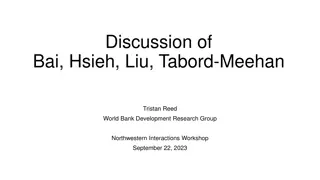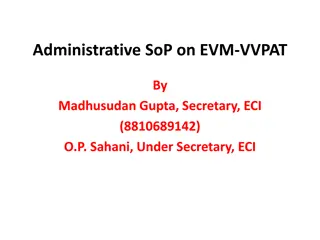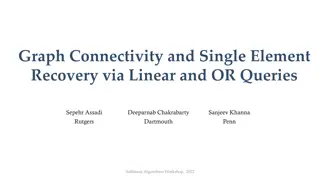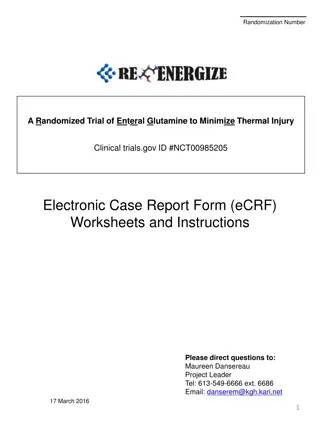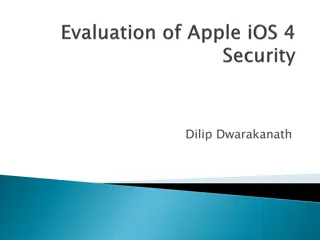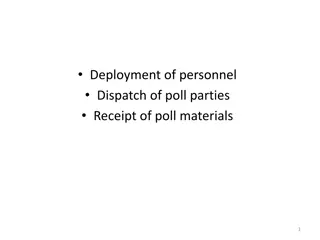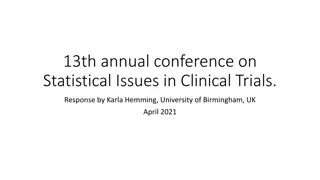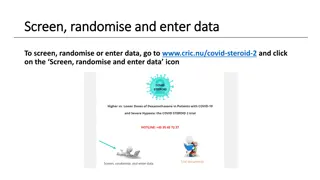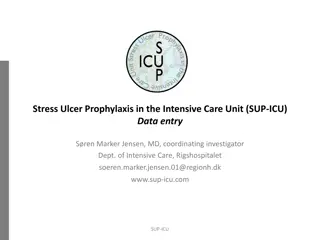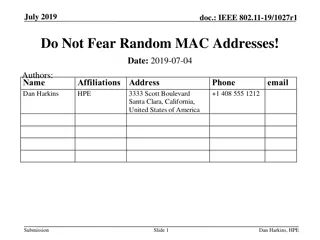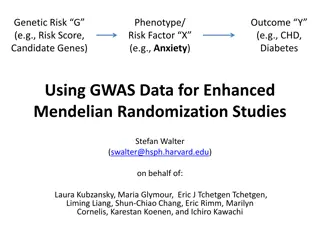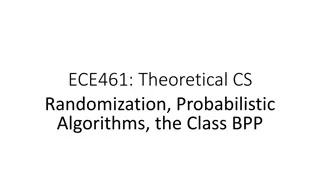Stack Based Attacks in Linux (an intro)
Explore the world of stack-based attacks in Linux through an introductory session presented by Bryce L. Meyer at the Saint Louis Linux Users Group. Covering topics from weaknesses to exploits, shellcode, and mitigations like stack canaries and address space randomization, this overview delves into c
7 views • 60 slides
Discussion of Randomized Experiments and Experimental Design Challenges
Randomized experiments face statistical power challenges due to rare outcomes and high variance. Stratifying randomization can help control for correlated residual variance based on baseline values of outcomes. Implications for applied economists include addressing attrition and treatment effect het
0 views • 6 slides
EVM-VVPAT Administrative Procedures for Election Management
This document outlines the standard operating procedures (SoP) for Electronic Voting Machines (EVMs) and Voter Verifiable Paper Audit Trail (VVPAT) systems used in elections. It covers the components of EVMs, the process of voting, the roles of polling officers, and various sub-topics such as storag
1 views • 58 slides
Design of Experiment in Animal Genetics & Breeding: Principles and Methods
Biostatistics and computer applications play a key role in the design of experiments in animal genetics and breeding. Proper allotment of treatments to experimental units is crucial to study treatment effects accurately. Designing experiments helps in maximizing information from available resources,
0 views • 37 slides
Randomization and the American Put: A Comprehensive Overview
The presentation delves into the concept of randomization in relation to the American put option, discussing its application with various distributions and the challenges in finding explicit solutions. It covers the Black-Scholes model, optimal exercise times, critical stock prices, and the implemen
1 views • 29 slides
Graph Connectivity and Single Element Recovery via Linear and OR Queries
The content discusses the concepts of graph connectivity and single element recovery using linear and OR queries. It delves into the strategies, algorithms, and tradeoffs involved in determining unknown vectors, edges incident to vertices, and spanning forests in graphs. The talk contrasts determini
0 views • 28 slides
Mitigating Conflict-Based Attacks in Modern Systems
CEASER presents a solution to protect Last-Level Cache (LLC) from conflict-based cache attacks using encrypted address space and remapping techniques. By avoiding traditional table-based randomization and instead employing encryption for cache mapping, CEASER aims to provide enhanced security with n
1 views • 21 slides
Electronic Case Report Form (eCRF) for Randomized Trial of Enteral Glutamine to Minimize Thermal Injury
Development of case report form worksheets for data collection in a randomized trial focusing on enteral glutamine use to minimize thermal injury. The document provides detailed instructions for research coordinators on data recording from medical charts to be entered into the electronic data captur
1 views • 61 slides
Comprehensive Course on Evaluation Methods and Impact Measurement
This comprehensive course covers topics such as evaluation methodologies, impact measurement, randomization, threats analysis, sampling techniques, cost-effectiveness analysis, and more. It also delves into the theory of change, log frame objectives, and practical applications through case studies a
0 views • 48 slides
Essential Elements of Clinical Trial Protocols
Understanding the key components of a clinical trial research protocol is essential for conducting successful studies. This includes identifying session objectives, discussing trial protocol contents, exploring observational study elements, and learning about reporting guidelines. Study objectives f
3 views • 25 slides
Privacy Issues in IEEE 802.11 Networks: Tracking and MAC Randomization
This presentation delves into the privacy concerns surrounding 802.11 networks, focusing on tracking vulnerabilities and the limitations of MAC randomization in preventing tracking. It discusses the ease of tracking devices, the risk of passive tracking due to MAC addresses being visible in frames,
1 views • 27 slides
Randomization and Initial Dispensing in ASPIRE Training
ASPIRE Training focuses on randomization and initial dispensing of prescriptions for the MTN-020 study. It involves assigning prescriptions in sequential randomization order, tracking prescription assignments, and completing two-part NCR prescription forms. Each prescription has a unique randomizati
0 views • 25 slides
Apple iOS 4 Security Evaluation - Insights on Code Signing and Exploitation Prevention
Dino A. Dai Zovi's paper on Apple iOS 4 Security Evaluation reveals insights into vulnerabilities like buffer overflow attacks and the effectiveness of security measures such as Address Space Layout Randomization and Code Signing Enforcement. Learn about the importance of Trust Certificates and how
1 views • 12 slides
Neonatal Respiratory Support Study Overview
This study focuses on evaluating the primary outcomes of length of hospital stay post-birth and incidence of severe respiratory failure in infants receiving respiratory support. Detailed logs are maintained daily until the infant is off respiratory support or discharged. The study is funded by NIHR.
1 views • 19 slides
Experimental Design and Bias in Statistics
Explore key concepts in statistics such as observational studies, experiments, bias, and sampling methods. Delve into the difference between observational studies and experiments, understand the impact of bias in research, and learn about sampling techniques like simple random sampling and stratifie
0 views • 22 slides
Design and Analysis of Experiments in STAT 337 with Ruba Alyafi
Investigate the principles of experimental design, randomization, replication, and blocking in the context of STAT 337 with instructor Ruba Alyafi. Explore topics such as sampling distributions, point estimators, population inference, and more through practical applications and assignments. Dive int
1 views • 40 slides
Implications of IEEE 802.11 State Machine and MAC Randomization
The document discusses the state machine transitions in IEEE 802.11, focusing on MAC address handling and implications for STA connectivity within an ESS. It explains the scenarios where a STA can use different MAC addresses, emphasizing the binding of state to specific address configurations and th
0 views • 11 slides
A Cluster Randomized Trial of a Village Doctor-Led Intervention on Blood Pressure Control: China Rural Hypertension Control Project
This study aimed to assess the effectiveness of a village doctor-led intervention on blood pressure control in rural China. The multifaceted intervention, compared to usual care, targeted residents with hypertension over 18 months. The project also tested the feasibility of a stricter blood pressure
1 views • 16 slides
Guidelines for Deployment of Personnel in Election Duties
Guidelines cover the deployment of various categories of staff, including presiding officers, police personnel, and more. It also outlines the authorities and organizations that can provide personnel. Additionally, it discusses the creation of a district database for randomization and specifies offi
0 views • 27 slides
Statistical Issues in Clinical Trials: Insights from 13th Annual Conference
The 13th annual conference on Statistical Issues in Clinical Trials covered topics such as penalties for extra variation and limited degrees of freedom, the Diet-Heart Hypothesis, controlled trials, unit of randomization, and causal inference. Speakers highlighted the importance of addressing cluste
1 views • 10 slides
Biostatistics Core Principles in Experimental Design for Research Studies
Gain insights into the core principles of biostatistics for research studies, including experimental design, sample size considerations, and involving a biostatistician. Learn to formulate clear research questions, determine treatment groups, and address potential sources of variability in your stud
0 views • 52 slides
Pediatric Blunt Head Trauma Management Study Findings
A study on children with blunt head trauma and normal CT scans investigated the need for hospitalization for neurological observation. The study design involved a prospective multicenter observational cohort with a primary randomization to hospital stay or discharge home. Sensitivity analysis and ne
2 views • 10 slides
Evaluating Salt Reduction Programs Through Sales Surveys
This study discusses the use of salt sales surveys as a simplified method to evaluate community-based salt reduction programs. It outlines the methodology, including randomization and data collection from shops in villages. The aim is to determine the effectiveness of these programs in reducing salt
0 views • 20 slides
MTN-028 Study Product Considerations Overview
The MTN-028 study focuses on product considerations for intravaginal rings in microbicide trials. It covers prescription completion, supply chain management, ring insertion process, return procedures, and handling of product complaints. The study regimen involves a 28-day duration per participant, w
0 views • 53 slides
Pediatric Seizure Management Eligibility Criteria in the Emergency Department
A series of scenarios involving pediatric patients experiencing seizures at home or upon arrival in the Emergency Department are presented. Each case outlines the administration of benzodiazepines, the timing of seizures, and the patient's eligibility for enrollment in a randomized study based on sp
0 views • 9 slides
The CLEAR Trial: Investigating Hypertonic Saline and Carbocisteine for Bronchiectasis Treatment
The CLEAR Trial is a 2x2 factorial randomized trial assessing the clinical and cost-effectiveness of hypertonic saline and carbocisteine for airway clearance in bronchiectasis patients over 52 weeks. Led by Professor Stuart Elborn and Professor Judy Bradley, the trial involves randomization, sealed
0 views • 8 slides
Efficient Solutions for Spy Problem: A Detailed Overview
Explore efficient strategies to identify spies among intelligence agents using methods like Single Holdout and Group Elimination. Learn about innovative approaches like CEASER for cache defense against new attacks, such as conflict-based cache attacks. Prior solutions and the CEASER framework are al
0 views • 19 slides
Experimental Studies in Epidemiology
Epidemiological studies and experimental studies play vital roles in understanding cause-and-effect relationships in research. Experimental studies involve manipulating independent variables and measuring dependent variables, with categories such as true experimental, quasi-experimental, and pre-exp
0 views • 22 slides
Effective Strategies for Experiment Design in Statistics
In experimental design, it is crucial to accurately define variables, levels of data, and experiment type, while using appropriate controls and understanding data distribution. Reducing noise in results involves increasing the signal-to-noise ratio through techniques like repeated measurements, incr
0 views • 8 slides
Threshold for Platelets Study: Prospective Trial on Platelet Transfusion
This study aims to determine the platelet count threshold for critically ill patients prior to invasive procedures. The trial update includes information on open sites, current recruitment status, and eligibility criteria. The agenda for the meeting covers trial updates, eligibility queries, screeni
0 views • 20 slides
Data Entry and Management Procedures for Clinical Trials
Detailed instructions on how to enter and manage data for clinical trials are provided in this content. It covers steps such as screening, randomization, data entry, use of electronic case report forms, and various forms to be completed throughout the trial period. The process involves both unblinde
0 views • 4 slides
Stress Ulcer Prophylaxis in ICU Data Entry System - SUP-ICU Overview
Dive into the Stress Ulcer Prophylaxis in the Intensive Care Unit (SUP-ICU) data entry system led by Dr. Soeren Marker Jensen. Explore screening, randomization, site overview, and data entry processes. Access participant details, edit submitted data, and learn about data entry guidelines. Enter the
0 views • 28 slides
Randomization and Permutation Tests in Statistical Analysis
Compare treatment effects or means using randomization and permutation tests in independent samples. Learn how these tests work, their procedures, models, algorithms, and applications with examples from NBA and WNBA players' body mass indices and England Premier League matches.
0 views • 20 slides
MAC Address Randomization in IEEE 802.11: Privacy Concerns and Solutions
The document discusses the rise of MAC randomization in IEEE 802.11 networks, addressing motivations, benefits, concerns over privacy implications, and real-life scenarios highlighting the risks associated with passive observation of MAC addresses. It emphasizes the importance of safeguarding privac
0 views • 14 slides
Summary-data-based Mendelian randomization to identify pleiotropic genes
Use summary data-based Mendelian randomization to study the correlation between diseases and risk factors, analyze randomized controlled trials, and explore genetic variants as instruments. Understand the factors affecting MR analysis and the limitations of individual-level data requirement.
0 views • 19 slides
Optimizing Spectrum Usage in IEEE 802.11 Standards
Explore techniques to suppress discrete spectrum components in PPDUs using midamble randomization in IEEE 802.11 standards. Learn about symbol randomization, midamble design, and MIMO PPDU application to enhance wireless communication efficiency.
0 views • 27 slides
Characteristics of Experimental Studies: Manipulation, Control, Randomization
Understand the key elements of experimental studies, including manipulation, control, and randomization. Experimental designs are recognized as the gold standard for inferring causal relationships, making them crucial in research. Identifying if a study is experimental involves looking for specific
0 views • 34 slides
Enhanced Mendelian Randomization Studies Using Genetic Risk Scores
Explore the application of genetic risk scores in enhanced Mendelian randomization studies to investigate the relationships between genetic risk, phenotypes such as anxiety and depression, and outcomes like CHD and diabetes using GWAS data. The study delves into projects focusing on anxiety, depress
0 views • 10 slides
Overview of ECE461 Theoretical Computer Science Randomization & Probabilistic Algorithms
Explore the concepts covered in ECE461, including computability theory, complexity theory, and the introduction of probabilistic Turing machines. Learn how randomization may enhance algorithm efficiency and tackle problems that are difficult to solve deterministically.
0 views • 17 slides
Understanding Body Temperature Distributions in Statistical Analysis
Explore how body temperature data is analyzed through bootstrap and randomization distributions to test hypotheses, centering around the average human body temperature. See the generation of randomization samples and the comparison between bootstrap and randomization distributions.
0 views • 12 slides

